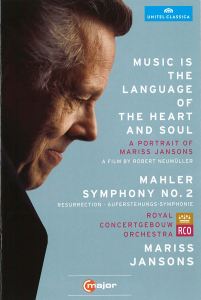 |
 |
|


alternatively
CD:
MDT
AmazonUK
AmazonUS
|
Gustav MAHLER (1860-1911)
Symphony no. 2 Resurrection [90:08]
A Portrait of Mariss Jansons : Music Is the Language of the
Heart
and Soul
A film by Robert Neumüller [51:37]
 Ricarda Merbeth (soprano); Bernarda Fink (mezzo);
Ricarda Merbeth (soprano); Bernarda Fink (mezzo);
Netherlands Radio Choir; Royal Concertgebouw Orchestra/Mariss Jansons
rec. live, Concertgebouw, Amsterdam, 3 December 2009
Booklet: English, German, French
Picture: NTSC, 16:9
Audio: PCM Stereo and DTS 5.1
Region Code: 0 (worldwide)
Subtitles: German, English, French, Spanish, Chinese, Korean
 UNITEL CLASSICA 709708
UNITEL CLASSICA 709708  [51:37 + 90:08]
[51:37 + 90:08]
|
|
|
Recently released, this two-disc set consists of a documentary
about the conductor Mariss Jansons. There's also a recent Jansons
performance of Mahler's Second Symphony from the Concertgebouw.
Jansons is a familiar presence at the podium as well as on recordings.
Robert Neumuller's documentary offers a vivid portrait of the
conductor. Illustrated with historic images from Janson's childhood,
youth, and early career, the documentary also benefits from
the firsthand account by the conductor himself. The German-language
interview is supported with subtitles in English, French, Spanish,
Chinese and Korean. Jansons' account of his life includes his
experience in Soviet Latvia, along with memoirs of growing up
in a musical family. Jansons' father was a conductor, whose
work inspired his son to pursue a career in music. It is useful
to hear the son's perspectives on his father's achievements.
Jansons also discusses his early career, and the excerpts included
in the documentary give evidence of his talent. Yet this documentary
also offers some insights into Jansons' artistic temperament,
which support the music which he interprets so well.
A case in point is the bonus disc included with the documentary,
a live performance of Mahler's Second. This recording merits
attention as a solid contribution to the discography of the
work. Jansons captures the style of the work from the start,
with a dramatically charged interpretation of the opening funeral
march. The rich, full sound gives a sense of what Jansons can
elicit from the Concertgebouw Orchestra, with the winds and
brass playing off the well-balanced core in the strings. Of
the strings, the incisive cellos are key to the interpretation,
with the articulation clear and biting. The horn passages have
an appropriate ring and the trumpet fanfares fit well into Jansons'
conception. The funeral march and idyllic reverie are juxtaposed
with appropriate contrast. Details in some of the figuration
and other elements are audible in this well-recorded concert.
Dramatic tension is sustained throughout. Jansons sets the conclusion
effectively which echoes the opening musical gesture of Mahler's
earlier cantata Das klagende Lied.
In paying respect to Mahler's instruction at the end of the
first movement, Jansons allows for a pause. Yet it is broken
by the entrance of the soloists, whom the audience greet with
warm applause. This momentarily detracts from the mood but it
resumes when the piece resumes in a lyrical interpretation of
the second movement. Here the Concertgebouw's cohesive strings
are at the forefront, as they respond to Jansons' direction
and follow him to the conclusion. A similar coherence is evident
in the Scherzo, in which Jansons shapes the phrases with an
ear toward the song that Mahler used as its basis, Des Antonius
von Paduas Fischpredigt. (“St. Anthony's Sermon to
the Fish”). In the trio, Jansons gives fine shape to the
quotation from the Scherzo of Hans Rott's Symphony in E, a piece
Mahler once planned to perform. With the reprise of the Scherzo
in the final portion of the movement, the dramatic intensity
Jansons achieves in the first movement is evident, as the thematic
fragments in the brass are present, but not overstated.
The fourth movement shifts appropriately to Bernarda Fink singing
from behind the orchestra. Fink's effortless Urlicht
is soulful and touching. The video focuses on the singer with
the camera angle conveying a sense of intimacy. This focus shifts
with the Finale, as the camera pulls back to encompass the entire
stage for the opening of the last movement. Its dramatic outburst
sets the tone visually for the music that follows. In this movement,
as in the rest of the performance, Jansons' command is evident.
He shapes the score with sensitivity to the various degrees
of dynamic and textural nuance. The images of the off-stage
players give physical documentation of the sometimes disembodied
sounds, a detail that adds to the production qualities.
With the choral passages that follow, the close-ups of Jansons
show his involvement with bringing out the text as he mouths
the words. This is reflected in the attentive faces of the chorus
who perform from memory. The absence of folders and choral scores
contributes to the intensity. This aspect and other elements
reinforce the focus on the musical interpretation. Ricarda Merbeth's
fine tone in the solo passages is nicely matched by Fink in
the duet that follows and later the mezzo solo “O glaube!
Mein Herz, o glaube”, leading into the final duet with
Merbeth. That section leads well into the choral Finale at the
culmination, with the contrapuntal setting of Klopstock's Auferstehung
sung intensely by the Netherlands Radio Choir. This is an outstanding
performance.
The visual aspects of the DVD fit the music, with crisp images,
realistic color and well-thought videography. The close-ups
of individual players or sections are not random, and the lighting
fits well into the entire effort. The camera angles from various
parts of the hall give a sense of the physical space, a detail
that contributes to the overall effect. Video director Joost
Honselaar deserves credit for fine imagery. It makes for a tribute
to Jansons work, which is celebrated appropriately in this release.
James L. Zychowicz
see also review by David McConnell of the Bluray release
|
|

